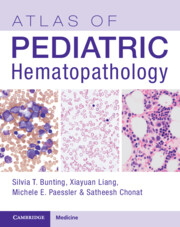Book contents
- Atlas of Pediatric Hematopathology
- Atlas of Pediatric Hematopathology
- Copyright page
- Contents
- Contributors
- Section I Peripheral Blood
- Section II Normal and Non-neoplastic Hematolymphoid Diseases
- Section III Mature Lymphoid Neoplasm
- Section IV Precursor Hematopoietic Neoplasms and Related Neoplasms
- Section V Histiocytic Neoplasm and Miscellaneous Bone Marrow Diseases
- Chapter 22 Histiocytic Lesions
- Chapter 23 Bone Marrow Manifestations of Systemic Diseases
- Index
- References
Chapter 22 - Histiocytic Lesions
from Section V - Histiocytic Neoplasm and Miscellaneous Bone Marrow Diseases
Published online by Cambridge University Press: 25 November 2023
- Atlas of Pediatric Hematopathology
- Atlas of Pediatric Hematopathology
- Copyright page
- Contents
- Contributors
- Section I Peripheral Blood
- Section II Normal and Non-neoplastic Hematolymphoid Diseases
- Section III Mature Lymphoid Neoplasm
- Section IV Precursor Hematopoietic Neoplasms and Related Neoplasms
- Section V Histiocytic Neoplasm and Miscellaneous Bone Marrow Diseases
- Chapter 22 Histiocytic Lesions
- Chapter 23 Bone Marrow Manifestations of Systemic Diseases
- Index
- References
Summary
Histiocytic disorders consist of many rare related and unrelated wide-ranging proliferations of cells supposedly derived from or sharing common immunophenotypes with macrophages (such as hemophagocytic lymphohistiocytosis) and dendritic cells (such as juvenile xanthogranulomas). These lesions can involve virtually any organ, resulting in an assortment of clinical presentations and prognostic outcomes that vary from localized incidental self-limiting lesions to multisystemic potentially fatal conditions that require chemotherapy or other aggressive treatments. Recent advances in our understanding of histiocytic lesions have shed new light on the pathophysiology of histiocytic disorders, revealing that many distinct entities have overlapping mutations of BRAF or other genes in the MAPK pathway [1]. In 2016, the Histiocyte Society proposed a revised classification system in which histiocytic disorders are sorted into five groups (summarized in Table 22.1) based on clinical, radiologic, histopathologic, immunophenotypic, and genetic/molecular characteristics [2].
- Type
- Chapter
- Information
- Atlas of Pediatric Hematopathology , pp. 257 - 269Publisher: Cambridge University PressPrint publication year: 2023



